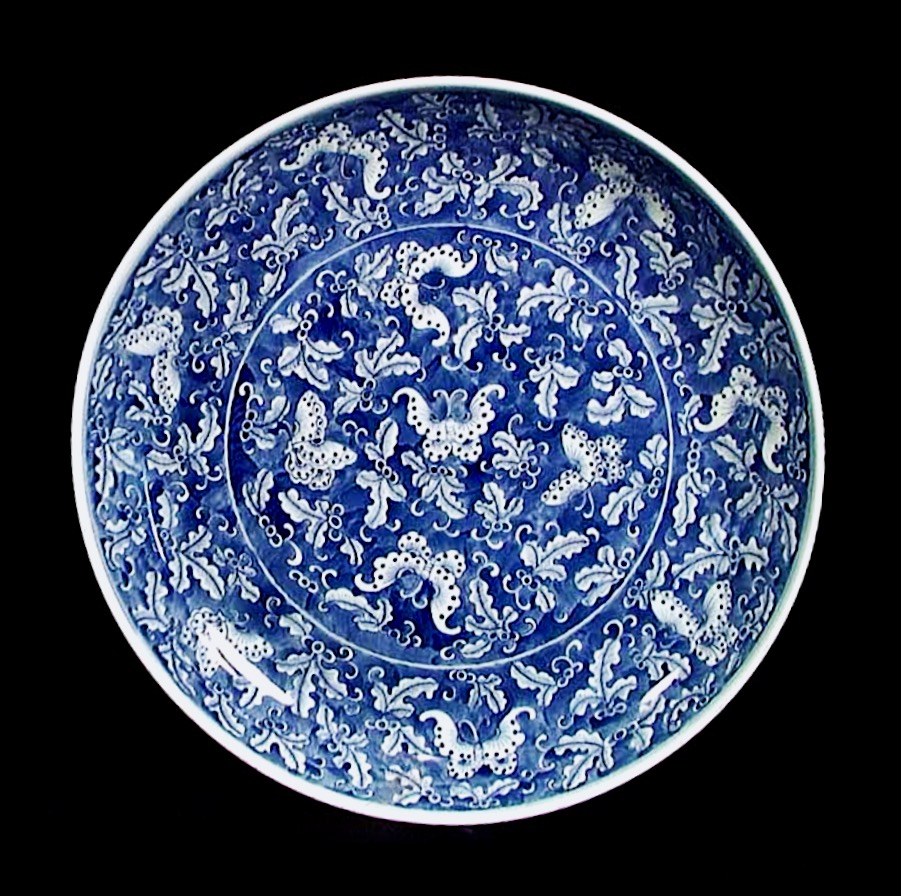

Title: Antique Blue and White Chinese Porcelain Pottery Ching Dynasty Platter
Shipping: $29.00
Artist: N/A
Period: 19th Century
History: Art
Origin: Central Asia > China
Condition: Excellent
Item Date: N/A
Item ID: 455
A spectacular hand-painted antique piece of Chinese porcelain pottery. AN EXCEPTIONAL LARGE CHING DYNASTY PLATTER, c. early 19th century. The fine blue & white porcelain platter is thickly covered with butterfly and leaf designs on the interior and under the exterior rim, six a character seal on the bottom. 2.5 x 14.75 inches. Choice type and condition. Provenance: Purchased by the current owner from a large Mid-Western collection in the 1990s, previously from a West Coast dealer in Asian art. The Ching Dynasty, also known as the Qing Dynasty, ruled China from 1644 to 1912. During this time, Chinese porcelain production reached new heights of technical excellence and artistic expression. Hand-painted porcelain platters were particularly popular during the 18th and 19th centuries and were often decorated with intricate floral designs, landscapes, and scenes from Chinese literature and history. These platters were highly prized by the Chinese imperial court and by wealthy merchants and were also exported to Europe and the Americas, where they were highly sought after by collectors. The Ching Dynasty was the last imperial dynasty in China and its fall marked the end of the imperial era in Chinese history. The bat was a popular motif in Chinese art and culture, particularly during the Qing dynasty, because it was considered to be a symbol of good luck and prosperity. The Chinese word for bat, "fu," is a homophone of the word "fu" which means good fortune or happiness. The bat is also one of the "Four Auspicious Animals" in Chinese culture, along with the dragon, the phoenix, and the qilin. In addition to its auspicious meaning, the bat was also a popular motif in porcelain decoration because of its distinctive shape and its ability to fly, which was seen as a symbol of freedom and transcendence. Bats were often depicted alone or in groups and often accompanied by other symbols of good luck, such as peaches or lingzhi mushrooms. During the early years of the Qing Dynasty, the demand for Chinese porcelain was high and the imperial court had an enormous appetite for luxury goods. The production of hand-painted porcelain was a major industry and the artisans used a variety of motifs to decorate the porcelain pieces, with the bat being a very recurrent one.
Chinese porcelain is considered valuable today for several reasons. First, it has a long history and cultural significance. Chinese porcelain has been made for over a thousand years, and it has played an important role in Chinese culture, art, and trade. Many of the porcelain pieces from the Ming and Qing dynasties, in particular, are considered masterpieces of Chinese art and craftsmanship. Second, Chinese porcelain is highly sought after by collectors and art enthusiasts. The intricate designs, fine details, and technical excellence of the porcelain pieces make them highly prized by those who appreciate the artistry and skill that goes into their creation. Third, many Chinese porcelain pieces are rare and hard to find. Many of the original pieces were lost or destroyed over time, and surviving examples are now highly prized. The complexity of the production process, along with the skill and expertise of the artisans, made the pieces exclusive and hard to replicate. Finally, Chinese porcelain has had a lasting appeal and is considered a long-term investment. The value of Chinese porcelain has appreciated significantly over time, and many pieces are considered valuable works of art that can be passed down from generation to generation. All of these factors contribute to the high value of Chinese porcelain today.